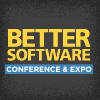Better Software Conference & EXPO 2004

PRESENTATIONS
|
Open Source Development Tools: Coping with Fear, Uncertainty, and Doubt
Using open source tools in a development and test environment can be a big relief for your budget. However, open source remains a foreign and often frightening concept for many developers and organizations. Today, open source options are available for all types of tools used in the development process. In this session, you will gain a better understanding of the tradeoffs between choosing open source and commercial tools. |
|
|
Patterns for Writing Effective Use Cases
Use cases are a wonderfully simple concept: document a system's functional requirements by writing down scenarios about how using it delivers value to its actors. However, writing effective use cases is more difficult than expected because you frequently must deal with difficult questions, such as: scope, level of detail needed for different people and projects, how to describe external interfaces, stored data, and more. You need a source of objective criteria to judge use case quality and effectiveness. |

Steve Adolph, WSA Consulting Inc. |
|
People + Process = ROI!
Return on investment (ROI) is a widely used approach for measuring the value of new or improved technology and business processes. Rather than limiting the discussion on ROI calculations to cost cutting measures, the most significant opportunities often come from addressing the overall business objectives. You need to step outside the focus of the IT department and relate improvements to opportunities for increased business revenue and customer value. |
|
|
Pervasive XML for the Agile Enterprise
XML technology usage continues to grow and is being incorporated in enterprise applications. Industry groups are embracing XML as a mechanism to encourage standard data interchanges within their vertical industry. XML is now common in Web applications, desktop software, services-oriented architectures, and application configurations. Learn about Hartford Financial Services Group’s challenges and successes developing and deploying an enterprise strategy for XML in all their application tiers. |
|
|
Preventing Security Breaches at the Source
Security is a complex and often overwhelming issue. You cannot rely solely on trying to prevent hackers from entering your systems. Instead, you must ensure that the system safeguards itself if a hacker does break in. Three of the most common internal software weaknesses hackers exploit are dangerously constructed SQL, buffer overflows, and runtime exceptions that are not properly handled. Although testing existing code for these defects can help, it is not fool proof. |
|
|
Process Improvement: Based on Models, Implemented in Reality
Experience demonstrates that no matter the end product-financial services, insurance, beer, construction, etc.-the foundation for and focus on implementing process improvement remains consistent. Using models as the basis for improving processes makes success more likely; however, no single model has all the right answers. |
|
|
QA Practice in High Maturity Organizations
If your organization aspires to higher maturity, such as CMMI® Level 4 or 5, your Quality Assurances process capability must measure up. As process action team leader, group process assessor, and trainer, Steven Thompson has developed, deployed, and maintained systems for quantitatively managing and continuously improving QA activities in his organization. |
|
|
Questions to Ask a Software Vendor about Security (and Verify) before Purchase
How do you choose which software vendor's product to buy? For a long time, CRM packages, ERP systems, and other commercial software selection criteria have come down to factors such as performance, compatibility, reputation of the vendor, support, and price. Security, though, has become a looming factor in the total cost of ownership and the risk of selecting one software product over another. Ed Adams describes the tough questions you need to ask vendors about security and how to extract critical information from them. |
|
|
Refining Requirements with Test Cases
Requirements are supposed to be the basis of most test cases, but can you use test cases to define what the system needs to do--to improve or to actually become the requirements? To some degree, your development process dictates the opportunities you have for test cases to define or refine requirements. However, everyone can benefit from test case writing techniques to identify missing requirements, surface ambiguous statements, and expose implied requirements early in the process. |
|
|
RequireMINTS - Fresh Approach to Analyzing Requirements
Studies show that most application defects are introduced before a single line of code is developed-with many (if not most) of these defects attributed to poor requirements. Studies also show that it is less costly to identify and correct these defects prior to code development. Despite this data, many of us have requirements analysis approaches that have become stale and are ineffective. Many analysts acknowledge that their processes need some improvement but feel helpless to do much about the problem. |

Dion Johnson, DiJiMax Consulting, Inc. |


